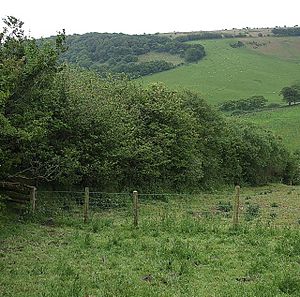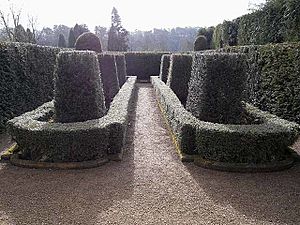Hedge facts for kids
A hedge or hedgerow is a line of shrubs and sometimes small trees planted very close together. People usually plant and shape them to create a barrier. Hedges often mark the edge of an area, showing who owns the land.
Contents
Hedges and Farming
Farmers use hedges to keep their livestock, like cattle, from wandering off. Before modern farming, hedges were much more common. Animals like hill sheep are harder to keep in fields. They often need a person and a dog to watch them, which costs money.
Today, many farms use large machines to harvest crops. Because of this, hedges have almost disappeared in some places.
When hedges are first planted, they are usually all the same type of plant. But over hundreds of years, more kinds of plants grow in them. Sometimes, full-grown trees also become part of the hedge. Many hedges in Europe are 500 or even 1,000 years old!
Fun with Hedges: Topiary and Mazes
Shaping hedges into cool designs is a special skill called topiary. Artists can turn hedges into animals, geometric shapes, or other amazing forms.
Sometimes, hedges are even used to create fun mazes. These mazes are popular attractions where people try to find their way out of a tricky path made of tall hedges.
Hedges for Wildlife
Hedges are super important for small birds and mammals. They act like the thick bushes and plants you'd find in an old forest. This means they provide safe homes for many creatures.
Birds often build their nests deep inside a hedge. This makes it hard for bigger animals that hunt to reach the nests. Hedges offer protection and a safe place for animals to live and raise their young.
Images for kids
-
A typical clipped European beech hedge in the Eifel, Germany.
-
Oak and beech hedges are common in Great Britain.
-
Trimmed hedges at Mission San Juan Capistrano in California.
See also
 In Spanish: Seto (barrera) para niños
In Spanish: Seto (barrera) para niños
















